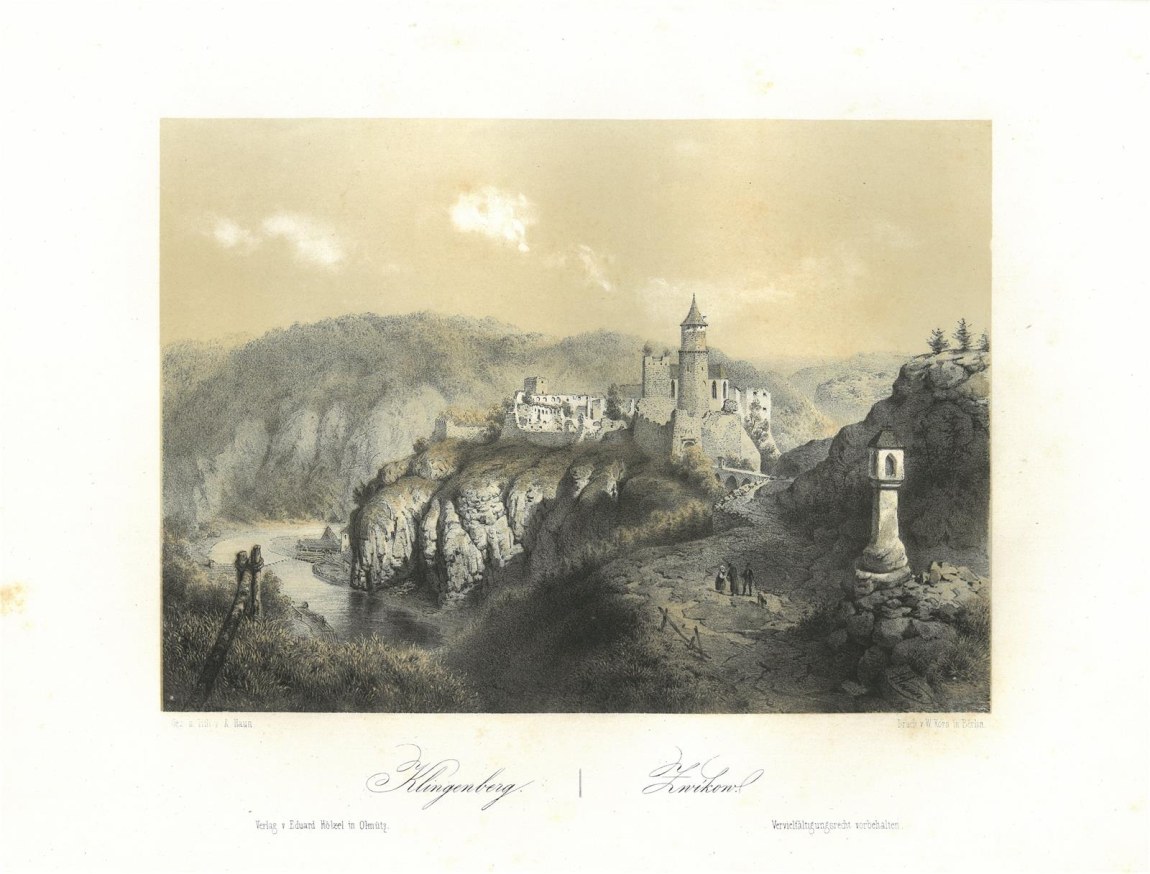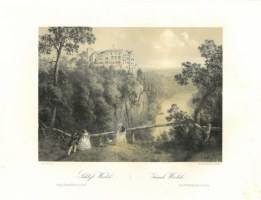Toned Lithographs from the Album Königreich Böhmen
› Detail › Toned Lithographs from the Album Königreich BöhmenExhibit of the Month 8 / 2024
The exhibit of the month presents a selection of two toned lithographs from the album Königreich Böhmen. This album of views, published by Eduard Hölzel in Berlin in 1864, contains 57 views – lithographs, some of which were colored. The individual sheets of the album depicted the appearance of castles, fortresses, and towns at that time, many of which have undergone significant changes since then. This is why this album is so significant for us. The late 18th century and the first half of the 19th century marked an increased interest in architectural monuments. During the Romantic period, there was also interest in various ruins, remnants of architecture, and so on, which literally gained a second breath thanks to this interest. This interest lasted until the mid-19th century and prompted the publisher Eduard Hölzel to collaborate with painter, draftsmen, and lithographers August Carl Haune, František Kalivoda, and Edvard Herold to publish an album of views of the Kingdom of Bohemia. There is still interest today in the appearance of places that have changed significantly to this day, and so the Argo publishing house reissued this album of views in 2007. As part of the exhibit of the month, we present two lithographs in August to encourage visitors to perhaps visit these places in their current form during their holidays.
Castle Worlik / Schloss Worlik
Orlík Castle (then Castle Worlik) is documented as early as the beginning of the 14th century as a fortress that served to protect the trade route and as a place for collecting tolls from navigation on the Vltava River. At the turn of the 13th and 14th centuries, it was expanded into a solid Gothic castle. Over time, Orlík often changed not only its owners but also its appearance – most often after fires that affected the castle almost every century. One of the most extensive and significant reconstructions was carried out in the Renaissance spirit by the Švamberk family after a devastating fire in the early 16th century, who had the castle thoroughly repaired, subsequently expanded, and raised by a second floor. In the first half of the 18th century, the northwest and then the southwest wings of Orlík were reconstructed. The lithograph shows the location of the castle before the construction of the Orlík dam, which was built between 1954 and 1961. The castle is surrounded by a vast English park, but due to the construction of the dam, the original area of 180 ha has been reduced to today's 140 ha, and the dam now forms one of the natural borders of the park. The current owner of the castle is Jan Nepomuk Schwarzenberg, son of Karel VII. Schwarzenberg.
Zwikow / Klingenberg
The history of Zvíkov Castle/Zwikow is connected with the royal Přemyslid family. Its foundation was likely carried out by Přemysl Otakar I, who, in exchange for six villages, also acquired the rocky promontory on which the castle is built. Zvíkov thus belongs to the most significant buildings of Czech medieval secular architecture. King Václav I also liked to stay at the castle. When in July 1247 the young prince Přemysl Otakar led a rebellion against his father, only Zvíkov Castle, along with Loket and Most, remained loyal to Václav I. It was at Zvíkov that King Václav I received the envoy of his son and the Czech nobility, whom he had imprisoned in the castle. The construction of Zvíkov gradually expanded in the mid-13th century with the royal palace and fortifications. The castle gained its greatest glory during the reign of Charles IV, who had it thoroughly repaired and liked to stay there. Before the construction of Karlštejn Castle was completed, Zvíkov also served as a temporary refuge for the coronation jewels. With the loss of this exclusivity, the significance of Zvíkov as a leading royal castle declined, and it began to frequently change owners. In 1719, the castle passed into the ownership of the Schwarzenbergs, who gradually began securing work, thanks to which the chapel and some wall paintings were saved. The condition of the masonry of the royal palace was already so poor that in 1829 the New Gate collapsed, followed by a landslide of part of the palace above the river. Therefore, after 1880, the reconstruction of the royal palace and the fortifications began. The original stone elements have a slightly pinkish color and are easily distinguishable from the newly inserted parts. Just like the nearby Orlík Castle, Zvíkov Castle was also affected by the construction of the Orlík dam, so the rocky promontory visible in the lithograph today only partially protrudes above the dam. Until 1948, the castle was owned by the Schwarzenbergs. It is now managed by the National Heritage Institute.




